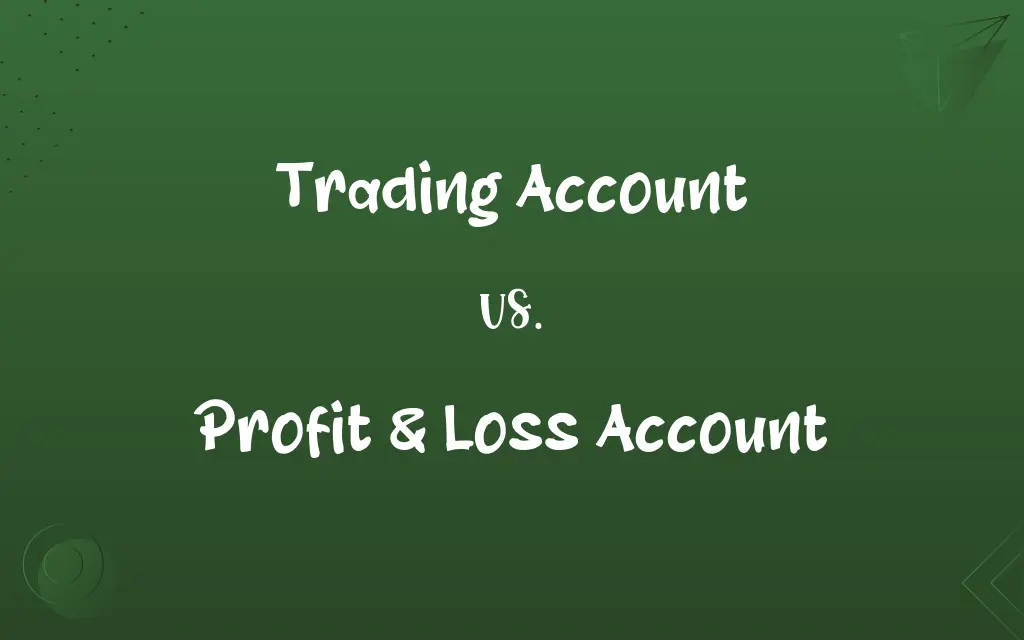Trading Account vs. Profit & Loss Account: Know the Difference

By Shumaila Saeed || Published on January 16, 2024
A Trading Account details a company's direct revenues and expenses related to goods, while a Profit & Loss Account shows overall profitability, including indirect expenses and revenues.

Key Differences
The Trading Account calculates the gross profit by matching sales with the cost of goods sold. The Profit & Loss Account, however, determines the net profit by considering all revenues and expenses, including indirect costs.
Shumaila Saeed
Jan 16, 2024
A Trading Account focuses on direct costs and revenues from trading activities. In contrast, the Profit & Loss Account encompasses a broader range of financial activities, including operating, financial, and extraordinary items.
Shumaila Saeed
Jan 16, 2024
Transactions in a Trading Account include purchases, sales, and direct expenses related to production. The Profit & Loss Account includes transactions like administrative expenses, financial costs, and non-operating incomes.
Shumaila Saeed
Jan 16, 2024
Both accounts are prepared for a specific financial period, but the Trading Account serves as a stepping stone to the Profit & Loss Account, which provides the final picture of the fiscal health.
Shumaila Saeed
Jan 16, 2024
The outcome of a Trading Account is Gross Profit or Loss, crucial for the Profit & Loss Account, which ultimately shows the Net Profit or Loss for the business.
Shumaila Saeed
Jan 16, 2024
ADVERTISEMENT
Comparison Chart
Focus
Direct trading activities like purchases and sales
All business operations, including indirect costs
Shumaila Saeed
Jan 16, 2024
Scope of Transactions
Includes direct expenses and revenues
Encompasses all expenses and revenues
Shumaila Saeed
Jan 16, 2024
Financial Indicator
Reflects efficiency in trading activities
Indicates overall financial health
Shumaila Saeed
Jan 16, 2024
Use in Financial Analysis
Used to analyze trading efficiency
Used to evaluate overall profitability
Shumaila Saeed
Jan 16, 2024
ADVERTISEMENT
Trading Account and Profit & Loss Account Definitions
Trading Account
A Trading Account reflects the trading efficiency of a business.
A high gross profit in their Trading Account suggested good pricing strategies.
Shumaila Saeed
Jan 08, 2024
Profit & Loss Account
It considers indirect expenses like administrative and selling expenses.
Marketing expenses were a significant part of the indirect costs in their Profit & Loss Account.
Shumaila Saeed
Jan 08, 2024
Trading Account
It includes direct expenses and revenues from the sale of goods.
In the Trading Account, direct costs like freight and manufacturing were deducted from sales revenue.
Shumaila Saeed
Jan 08, 2024
Profit & Loss Account
It helps in assessing the overall profitability of a business.
Despite a gross profit, the Profit & Loss Account revealed a net loss due to high loan interests.
Shumaila Saeed
Jan 08, 2024
Trading Account
It is the first step in the preparation of final accounts.
After preparing the Trading Account, they moved on to the Profit & Loss Account for more insights.
Shumaila Saeed
Jan 08, 2024
ADVERTISEMENT
Profit & Loss Account
A Profit & Loss Account shows the net profit or loss by including all revenues and expenses.
Their Profit & Loss Account indicated a net loss, reflecting high administrative costs.
Shumaila Saeed
Jan 08, 2024
Trading Account
A Trading Account is used to calculate the gross profit or loss from business operations.
Their Trading Account showed a gross profit, indicating efficient management of inventory and sales.
Shumaila Saeed
Jan 08, 2024
Profit & Loss Account
The account is crucial for stakeholders to understand financial health.
Investors scrutinized the Profit & Loss Account to gauge the company's financial stability.
Shumaila Saeed
Jan 08, 2024
Trading Account
The Trading Account focuses on costs of goods sold and sales.
The Trading Account revealed how changes in supplier costs impacted their sales profitability.
Shumaila Saeed
Jan 08, 2024
Profit & Loss Account
The account provides a comprehensive view of financial performance.
The Profit & Loss Account showed how non-operating income boosted overall profits.
Shumaila Saeed
Jan 08, 2024
Repeatedly Asked Queries
Why is a Trading Account important?
A Trading Account is important to assess the efficiency of a company's trading activities and direct costs.
Shumaila Saeed
Jan 16, 2024
Can a Profit & Loss Account show a net loss?
Yes, a Profit & Loss Account can show a net loss if total expenses exceed total revenues.
Shumaila Saeed
Jan 16, 2024
How is gross profit calculated in a Trading Account?
Gross profit in a Trading Account is calculated by deducting the cost of goods sold from sales revenue.
Shumaila Saeed
Jan 16, 2024
What does a Profit & Loss Account include?
A Profit & Loss Account includes all operational, financial, and extraordinary incomes and expenses.
Shumaila Saeed
Jan 16, 2024
What is a Profit & Loss Account?
A Profit & Loss Account is a comprehensive statement that shows the net profit or loss of a business, considering all revenues and expenses.
Shumaila Saeed
Jan 16, 2024
Can a Trading Account have a gross loss?
Yes, if direct expenses exceed sales, the Trading Account will show a gross loss.
Shumaila Saeed
Jan 16, 2024
What are direct expenses in a Trading Account?
Direct expenses in a Trading Account include costs directly associated with the production or purchase of goods.
Shumaila Saeed
Jan 16, 2024
What is a Trading Account?
A Trading Account is a financial statement that calculates gross profit or loss from core business activities.
Shumaila Saeed
Jan 16, 2024
Is depreciation considered in a Profit & Loss Account?
Yes, depreciation is an expense considered in the Profit & Loss Account.
Shumaila Saeed
Jan 16, 2024
Who uses the Trading Account?
Business owners, managers, and financial analysts use the Trading Account to assess trading efficiency.
Shumaila Saeed
Jan 16, 2024
Does a Trading Account include non-operating revenues?
No, non-operating revenues are not included in a Trading Account but are in the Profit & Loss Account.
Shumaila Saeed
Jan 16, 2024
Are salaries included in a Profit & Loss Account?
Yes, salaries, being an indirect expense, are included in the Profit & Loss Account.
Shumaila Saeed
Jan 16, 2024
How does a Trading Account differ from a Balance Sheet?
A Trading Account focuses on trading activities, while a Balance Sheet shows the financial position at a point in time.
Shumaila Saeed
Jan 16, 2024
How often are Profit & Loss Accounts prepared?
Profit & Loss Accounts are typically prepared annually, but can be done quarterly or monthly for internal purposes.
Shumaila Saeed
Jan 16, 2024
Are taxes included in the Profit & Loss Account?
Yes, taxes are included as an expense in the Profit & Loss Account.
Shumaila Saeed
Jan 16, 2024
Does a Trading Account show financial stability?
A Trading Account alone does not show financial stability; it must be assessed in conjunction with the Profit & Loss Account.
Shumaila Saeed
Jan 16, 2024
Can stakeholders rely on the Profit & Loss Account?
Yes, stakeholders rely on the Profit & Loss Account for insights into a company's overall financial performance.
Shumaila Saeed
Jan 16, 2024
What’s the first step in final account preparation?
The first step is preparing the Trading Account, followed by the Profit & Loss Account.
Shumaila Saeed
Jan 16, 2024
Is inventory turnover reflected in the Trading Account?
Yes, inventory turnover is reflected in the Trading Account through the cost of goods sold.
Shumaila Saeed
Jan 16, 2024
How do investors use the Profit & Loss Account?
Investors use the Profit & Loss Account to evaluate a company's profitability and investment potential.
Shumaila Saeed
Jan 16, 2024
Share this page
Link for your blog / website
HTML
Link to share via messenger
About Author
Written by
Shumaila SaeedShumaila Saeed, an expert content creator with 6 years of experience, specializes in distilling complex topics into easily digestible comparisons, shining a light on the nuances that both inform and educate readers with clarity and accuracy.









































































